February 9, 2007
Air Date: February 9, 2007
FULL SHOW
SEGMENTS
Getting Particular About Particulates
View the page for this story
A new study looks at the link between tiny particulate air pollution and cardiovascular disease. The study of more than 65,000 post-menopausal women shows that longterm exposure to these pollutants dramatically increased the incidence of cardiovascular death. Host Steve Curwood talks with Dr. C. Arden Pope, an epidemiologist and economist at Brigham Young University. (05:00)
**WEB EXTRA**
View the page for this story
Host Steve Curwood speaks with Dr. Douglas Dockery of the Harvard School of Public Health who wrote an editorial about the New England Journal of Medicine study. (25:05)
EPA Takes Flack Over Soot
/ Jeff YoungView the page for this story
Critics say EPA won't pay for monitors that measure deadly particulate pollution and won't pay attention to the agency's own scientists who warn of health risks. Living on Earth's Jeff Young reports on the fallout from EPA's decisions on soot. (06:30)
Jakarta Water Woes
View the page for this story
Jakarta, the capital city of Indonesia, has been devastated by severe flooding in recent weeks, and heavy rains aren't the only reason why. Stephen Fitzpatrick is the Jakarta correspondent for The Australian newspaper and he joins host Steve Curwood to discuss the crisis and some of its possible causes. (08:15)
Elk Farming or Hunting?
/ Guy HandView the page for this story
The elk, an icon of the West, is increasingly being raised on private ranches in Idaho. Elk meat is a popular menu item in restaurants and some ranches allow hunting. But many hunters and some wildlife experts object to confined elk. Producer Guy Hand reports. (09:15)
Borneo: Deforestation and Discovery
View the page for this story
In Borneo, the demand for palm oil is threatening to destroy the habitat of some of the world’s most diverse wildlife. The World Wildlife Fund’s Adam Tomasek tells host Steve Curwood that his group has teamed up with the three countries that govern Borneo to implement a plan to protect the island nation’s diversity. (08:30)
Low-Carb Diet For Your Car
/ Ingrid LobetView the page for this story
The issue of climate change has ushered in a whole new lexicon to describe the effects of the warming of the planet, as well as possible solutions. Living on Earth’s Ingrid Lobet reports on the emergence of a new term you’re likely to hear a lot more of – “low carbon fuel.” (02:45)
Mush On!
/ Ed JanusView the page for this story
Producer Ed Janus takes us dog sledding in the snow-quiet northern woods of the Bayfield Peninsula in Wisconsin. Whoosh! (05:15)
This week's EarthEar selection
listen /
download
A male gibbon looks for love in a Borneo jungle.
Show Credits and Funders
Show Transcript
HOST: Steve Curwood
GUEST: Dr. C. Arden Pope, Stephen Fitzpatrick, Adam Tomasek
REPORTER: Jeff Young, Guy Hand, Ingrid Lobet, Ed Janus
[THEME]
CURWOOD: From Public Radio International - this is Living on Earth.
[THEME]
CURWOOD: I’m Steve Curwood.
Scientists have found older women living in cities that meet federal standards for particulate air pollution may run nearly twice the risk of dying from a heart attack than those living in cleaner cities.
POPE: It suggests the standard itself is not strictly protective of everybody in terms of exposure.
CURWOOD: Also, you expect birds, bats, and insects to fly- and maybe even the odd squirrel,- but how about frogs, lizards and even snakes? It’s all part of the amazing diversity of the Asian island of Borneo.
TOMASEK: The island itself holds an unbelievable amount of unique animals and plants, the more famous ones such as the orangutans, pigmy elephants, rhinoceros, the gibbons and the other monkeys the Proboscis monkey, lizards and snakes galore.
CURWOOD: Protecting biodiversity on Borneo and more, this week on Living on Earth. Stick around!
[NPR NEWS CAST]
ANNOUNCER: Support for Living on Earth comes from the National Science Foundation and Stonyfield Farm.
Getting Particular About Particulates

Diesel truck (Courtesy of Maine Department of Environmental Protection)
CURWOOD: From the Jennifer and Ted Stanley Studios in Somerville, Massachusetts, this is Living on Earth. I’m Steve Curwood. You may instinctively cover your nose and hold your breath when a diesel motor belches a black cloud in your direction, but it turns out that it’s what you can’t see that’s most harmful. Scientists have known for years that it’s the tiniest invisible particles in soot and exhaust that can cause the most harm. In the 1990’s Harvard researchers calculated that as many as 70,000 Americans die prematurely every year from tiny particle pollution, mostly from diesel engines and coal-fired power plants.
And now the New England Journal of Medicine has published a study out of the University of Washington of 66,000 postmenopausal women that indicates the death rate may be even higher. In some of America’s cities with the dirtiest air, such as Pittsburgh, Cincinnati, and the Los Angeles basin, this latest study indicates the risk of death from cardio-vascular disease for those women is close to that of active smokers.
CURWOOD: Dr. C. Arden Pope is an epidemiologist and economist at Brigham Young University in Utah who studies particulate pollution. Dr. Pope thanks for joining us.
POPE: Thank you.
CURWOOD: Perhaps we should start with a little lesson on particulate size. Why does size matter when we’re talking about particulate air pollution especially in relation to this study?
POPE: Well there’s two reasons that size matters. First, is that course particles, particles that are relatively large, are often naturally-occurring. They come from wind blown dust and other natural sources. These particles do not seem to be especially toxic. That’s because chemically they’re different. It’s also because they’re of a size that do not penetrate deeply into the lungs. Fine particles, particles less than two and a half micrometers in diameter are much more serious. And the reason is they’re chemically more toxic. They come primarily from combustion processes. Furthermore their size is such that they can be breathed deeply into the lungs and therefore cause more problems.
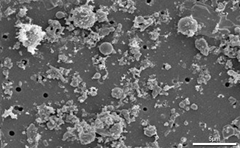
"A magnified view of aerosol particles collected in the industrial city of Port Talbot, England. Many of the particles measure roughly 2.5 microns across, small enough to easily enter and damage human lungs." (Courtesy of NASA/MRC Institute for Environment and Health)
POPE: What’s new about this study is two things. One is it focuses primarily on women; postmenopausal women. And two, it observes effects that are substantially larger than have been observed in previous studies. There have been two other studies that have looked at cardiovascular death in both men and women: the Harvard Six City Study and the American Cancer Society study. And both of these studies did observe that cardiovascular death, or at least the risk of cardiovascular death, was increased with long-term exposure to fine particle pollution. This study focused on women, and not only observed that the risk of cardiovascular death is increased with exposure, but that increase risk is substantially higher than what was observed in the previous studies. The difference is roughly two to three times higher than what we had estimated earlier.

Diesel truck (Courtesy of Maine Department of Environmental Protection)
CURWOOD: Can you break that down for me?
POPE: Basically what they did is they followed up postmenopausal women that did not have cardiovascular disease and then over a period of approximately six years they looked at which women developed cardiovascular disease and which women died of cardiovascular disease. What they learned is that individuals exposed to ten micrograms per meter of pm2.5 had a 24 percent increased risk of having cardiovascular events and a 76 percent increased risk of dying from cardiovascular disease. Interestingly enough, they also looked at cerebral vascular events.
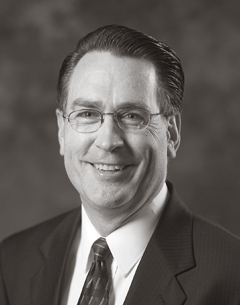
C. Arden Pope is the Mary Lou Fulton Professor of Economics at Brigham Young University (Photo: Brigham Young University)
CURWOOD: Strokes you mean.
POPE: Basically strokes. Basically ischemic strokes but uh, it was amazing that even ischemic strokes or these cerebral vascular events, were associated with increased levels of pm 2.5. And in fact for every 10 microgram per cubic meter increase in pm 2.5, there was about a 35 percent increase in these cerebral vascular events or primarily strokes.
CURWOOD: Now the current EPA limit for fine particles in the air on a long-term basis- I believe- is 15 micrograms per cubic meter. What does this study say to you about that limit?
POPE: Well, this study as well as numerous other studies, seems to suggest that the exposure-response relationship between air pollution and cardiovascular and respiratory disease is near linear. That is to say there’s no clear threshold where exposure to air pollution is strictly safe. And so that is a bit troubling on the one hand because it suggests that even air pollution below 15 micrograms per cubic meter can have impacts on our health. It’s good news also, in the sense though, that if we make efforts to improve our air quality even at levels below 15 micrograms per meter we will get improvements in health. So it suggests that the standard itself is not strictly protective of everybody in terms of exposure.
CURWOOD: Dr. Pope thank you so much.
POPE: You’re welcome.
CURWOOD: Dr. C. Arden Pope is an epidemiologist and economist at Brigham Young University in Utah. He spoke to us about the Women’s Health Initiative study on fine particulates, published in the recent issue of the New England Journal of Medicine.
The issue also includes editorial comments from Dr. Douglas Dockery, at the Harvard School of Public Health, who was one of the authors of the original Harvard Six Cities Study. To get more details and hear an interview with Dr. Dockery, go to our website, loe dot org.
Related links:
- To download a PDF file of the study "Long-Term Exposure to Air Pollution and Incidence of Cardiovascular Events in Women" in the New England Journal of Medicine click here.
- The New England Journal of Medicine: "Cardiovascular Risks from Fine Particulate Air Pollution" by Douglas W. Dockery, Sc.D., and Peter H. Stone, M.D.
- C. Arden Pope's website
**WEB EXTRA**
EPA Takes Flack Over Soot

Senator Barbara Boxer, Chair of the Senate Committee on Environment and Public Works (Courtesy of the U.S. House of Representatives)
CURWOOD: The regulation of fine particulates continues to bedevil the U.S. Environmental Protection Agency. Other air pollutants have decreased in recent years, but EPA records show that tiny particle pollution has gotten worse. And last year EPA Administrator Stephen Johnson touched off a controversy when he ignored his own science advisors on particulates. They had recommended a stricter health standard, tighter than the 15 micrograms per cubic meter that Dr. Pope just spoke about. Now, the EPA is under fire for changing the process those scientists use and cutting the budget for measuring tiny particulates. Living on Earth’s Jeff Young reports from Capitol Hill.
[SOUND OF MACHINES]
YOUNG: Near the center of Washington DC sits a white trailer with a roof full of
whirring metal machines keeping constant vigil on the capital’s air. Bill Becker’s biggest interest here, is the machine that measures the tiniest particles.
BECKER: The soot that is less than two and a half microns, um, which a fraction of the diameter of a piece of hair. It is very, very small.
YOUNG: Becker is with the National Association of Clean Air Agencies. He says monitors like this one alert people with breathing problems when the air is bad. And the monitors tell air officials when they need to do more to control fine particles.
BECKER: This is the foundation of every agency’s regulatory program. So without that data, agencies are at a loss for notifying the public and knowing whether or not the air is clean or not.
YOUNG: Becker says the Environmental Protection Agency’s budget would cut funds for
these monitors around the country by 17 million dollars- a 40 percent hit. Clean air advocates say the budget cuts are the latest in a string of troubling EPA decisions when it comes to fine particles: from not paying for the machines that gather raw data to not paying attention to the agency’s top science panel.
EPA’s clean air science advisers, a group known as CASAC, studied the mounting evidence linking fine particles to cardiovascular disease and premature deaths. The advisors recommended a stricter standard for fine particles last year, but EPA administrator Stephen Johnson rejected their recommendation. Then he changed the CASAC advisory process in a way that critics say limits the input of scientists. Now the new chair of the US Senate’s environment committee is taking Johnson to task.
BOXER: EPA’s actions make it clear who EPA is protecting, and sadly it is not the American people.

Senator Barbara Boxer, Chair of the Senate Committee on Environment and Public Works (Courtesy of the U.S. House of Representatives)
YOUNG: California Democrat Barbara Boxer called Johnson before her committee to
explain what she called "rollbacks" in environmental protection that favor polluters.
Johnson sat blinking in the witness chair like a man bracing for a blow. And true to her name, Boxer delivered. Her haymaker punch came with this description of Johnson’s changes to the agency’s scientific process.
BOXER: Instead of basing health standards on the best science they will now inject politics into the entire decision. Under EPA’s plan, key scientists will no longer work directly with top government officials to help set health standards. You took the science out of the clean air rule and stuck it at the end of the process. Nobody’s fooled by this. Here’s the point. These rollbacks were done in the dead of night. And it’s over, in terms of your not having to come before the committees of Congress to respond to them.
YOUNG: Johnson is the first career scientist to lead EPA, and he seemed stung as he
hurried from the hearing room. Reporters caught him waiting for an elevator, where he defended his changes to clean air science. Johnson says the science advisors simply take too long.
JOHNSON: There’s something wrong with the process. And that’s why I asked our deputy to initiate a top down look at the entire program.
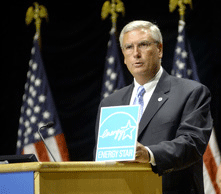
EPA Administrator Stephen Johnson (Courtesy of the U.S. Department of Energy)
YOUNG: The science advisors of CASAC are supposed to update findings on major pollutants every five years. But Johnson says their cumbersome process means they rarely meet that deadline. He says his changes will allow the committee to work quickly while still considering a full range of views.
JOHNSON: And by the process that we’ve laid out, it very clearly defines, where the science input is and where the policy input is. I think this is much improved, we will have better and greater science influence at the same time being able to draw a very clear distinction between what is science and what is policy.
YOUNG: But many of the CASAC scientists disagree. The same morning Johnson squirmed in Boxer’s hot seat, the science advisors met to voice strong opposition to
Johnson’s changes. University of California medical professor, John Balmes, is a CASAC member. Balmes agrees the process should be streamlined. But he says Johnson went too far when he eliminated the step that lets scientists and EPA workers compile the most important science in a staff paper.
BALMES: The staff paper, or some other document that would be its equivalent, is vitally important and I believe that all of the CASAC members agree with me on that.
YOUNG: Balmes says the changes make EPA’s political appointees more powerful and
reduce science advisors to the same level as lobbying groups making comment. And Balmes says Johnson’s real motivation goes back to the disagreement over fine particles. The science advisors openly criticized Johnson for being the first EPA administrator to ignore their recommendations.
BALMES: The conflict between the- what the administrator wanted to do in terms of policy, and what the science shows,- was embarrassing to the administration. So if you get embarrassment, then just get rid of the staff paper. Then you won’t have to worry about embarrassment.
YOUNG: Some of the advisors say they are sending Johnson a letter protesting his
changes to the science process. And until the issue is settled it’s not clear how great a role science will play in setting EPA’s health standards. For Living on Earth, I’m Jeff Young in Washington DC.
Related links:
- EPA: Air Emmissions Trends
- Air Quality Trends by city
- National Assoc. of Clean Air Agencies: Impact of Proposed FY 2007 Budget Cuts on State & Local Air Quality Agencies
- U.S. Senate Committee on Environment and Public Works: Full Committee Hearing on Oversight of Recent EPA Decisions
[MUSIC: TV On The Radio “Things You Can Do” from ‘Return to Cookie Mountain’ (Touch & Go - 2006) ]
CURWOOD: Coming up it’s Indonesia’s version of New Orleans after Katrina—only this time it’s millions of people who’ve been flooded out by monsoon rains in the capital, Jakarta.
That’s just ahead on Living on Earth.
[MUSIC: John Dunn “(Music created from) Human Sex Hormone DNA” from ‘Life Music: The Sonification of Proteins’ (Algorhythmic Arts – 1992)]
Jakarta Water Woes
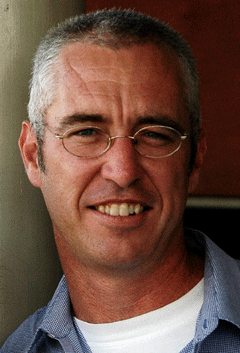
The Australian reporter, Stephen Fitzpatrick. (Courtesy of Stephen Fitzpatrick)
CURWOOD: It’s Living on Earth. I’m Steve Curwood. Life can be challenging in Indonesia. The tsunami of 2004 killed 160,000 people. The bird flu has claimed its most human victims so far in this island nation. And now for the third time in a decade, torrential rains have caused catastrophic flooding in its capital, Jakarta. It’s only the start of the monsoon season and the 12 million or so people who live along the city’s 13 rivers are bracing for even more rain. On the line with me now from Jakarta is Stephen Fitzpatrick. He's a correspondent for the newspaper, The Australian. Hi there.
FITZPATRICK: Hi there, how are you?
CURWOOD: So, tell me, just how bad has it been there in Jakarta this monsoon season?
FITZPATRICK: Well, since the night of February one, when a bunch of rivers broke their banks, up to, anywhere up to 70 percent of Jakarta has been flooded and pretty much made uninhabitable. So people even in the last couple days as the situation has eased a little bit might have, for instance, left their area and gone back as the waters recede and then discovered that they're suddenly flooded again and have to leave so it’s been difficult for the city.

The Australian reporter, Stephen Fitzpatrick.
(Courtesy of Stephen Fitzpatrick)
CURWOOD: Monsoon is very much a part of life and culture in Indonesia. Every year they’re expected. What makes this particular monsoon season so much worse than previous rainy seasons?
FITZPATRICK: Yes, well very good question and if you listen to the Governor of Jakarta answer it we just all should have known that it would come and could have done nothing about it. He says, “Well it was just a lot more rain than we expected and what am I supposed to do?” Of course the criticism that’s directed back at him in response to that is that, planning, or unplanned development in the city has been allowed to go on at a furious pace and that that has swallowed up areas that were previously effectively water run-off areas. Um, the mountainous area to the south has been subject to some fairly severe deforestation. It’s a city that’s outstripped its ability to cope with natural occurrences like the annual monsoon season. And in fact, perhaps you get the debate at a moment like this about, about what to do about it. And a lot of that debate I might suggest will be forgotten in the coming weeks. But one of those conversations from, really from City Hall down at the moment is the ongoing one about should we move the capitol somewhere south? The land area we’ve got here just isn’t big enough to cope with running a central government as well as the commercial functions.
CURWOOD: Tell me about the infrastructure there. Now, Indonesia was for a long time was a Dutch colony. Of course much of the Netherlands is under water. The Dutch are pretty good at building dikes and waterways and canals. What does Jakarta have?
FITZPATRICK: Yeah, well it has dikes and water ways and canals built by the Dutch. Unfortunately, they haven’t really been improved since the Dutch built them about 200 years ago. And that’s one of the basic problems. A goodly part of Jakarta City is actually below sea-level, which is one of the major problems. There’s currently a project to build a major east-west canal, a new canal, that would be able to distribute major flooding waters. But that’s bogged down in politics and you know, land acquisition issues, and that could be several years away if it’s ever finished.
CURWOOD: Now, I’m looking at an editorial from the Jakarta Post and the title is, “Oops We All Did it Again.” Have people come to expect this sort of disaster in Indonesia?
FITZPATRICK: Yes they have, well certainly in Jakarta. But across the whole country, I mean obviously this is quite a spectacular event over the past week and a bit in the capitol. But every wet season there are landslides and rivers breaking their banks and people dying as a result of all of that right across the country. And there tends to be a little bit of a shoulder-shrug about it all. And a quick "send in some rescue teams and people with rubber boats and whatever can be assembled to deal with those situations."
CURWOOD: Now, I’m told that the "que sera" attitude about all this might be linked to the fact that most people affected by this are very poor.
FITZPATRICK: In general most people, most people affected by natural disaster in Indonesia tend to be. That’s been one of the interesting things of the current disaster in Jakarta is pretty much everyone has been affected and pretty much all areas of the city have been flooded. So, slum areas along river banks get flooded every year regular as clockwork. You can speak to people who live in these slum areas and who say, “I grew up here, my mother grew up here, and the floods come every year and we just sit on the roof when the floods come and go back and clean up the house when they go.” And there’s an expectation that that’s just how life is.
CURWOOD: What concerns about climate change have entered into the debate and discussion about this monsoon disaster?
FITZPATRICK: I would have to say none, and for probably a range of reasons. The level of debate about environmental issues generally in Indonesia tends not to be a very far reaching one. And there’s a lot of reasons for that. One of them is that many issues- development- in Indonesia tend not to have long-term concerns, and often tends to have fairly short-term and quick profit based concerns.
CURWOOD: So, what are the health implications of a disaster of this scale? I mean the water can’t be all that clean that’s been flooding the city.
FITZPATRICK: No the water is filthy. And it’s not just the water that’s flooding the streets but town water generally in Jakarta, is not fit for consumption in general and there’s a huge bottled water industry. But often in homes people will use ground water, well water, but that well water has all been polluted by the flood so it’s become unusable. There is serious fears of gastrointestinal diseases, skin infection type diseases. The other significant health risk which Indonesia, and Jakarta especially has been battling in recent months is dengue fever. The number of dead, from dengue, before these floods was in the dozens. And that possibly is only going to increase with the ability for the dengue-carrying mosquito to breed in all this water.
CURWOOD: So with all the stress on the public health system there in Jakarta and Indonesia, Indonesia is also the epicenter right now of the avian flu outbreak. Now there are not many people that have it yet, but what concerns are there that with all the chaos that’s going on something could happen to bird flu there?
FITZPATRICK: There’s no suggestion that there will be an increase in infections directly as a result of the floods other than the general, general health problems. People are more likely to get sick when they’re stressed and already not very healthy. So, I guess that’s entirely likely. I think more specifically on the bird flu issue there’s a, at the moment, a general sense of "wait and hold your breath" because there’s every chance that it will explode. And although Indonesia leads the world- unfortunately leads the world- in the number of deaths directly attributed to bird flu, it so far remains in check. But there’s a very real concern that that situation could change and could change very quickly.
CURWOOD: So how were you affected by this flooding?
FITZPATRICK: Personally?
CURWOOD: Yes.
FITZPATRICK: Well, I was very fortunate in that I live right in the inner city, ah very close to my office, which was a very deliberate choice because in general you can’t get around Jakarta during peak-hour traffic times at all, so it makes sense to live close to where you work if at all possible. And I was just very lucky that my little section of Jakarta doesn’t seem to have flooded. I mean I live only 100 meters from one of the 13 rivers. I can look across the other side and I can see the Four Seasons hotel which has been flooded on the other side of my river so I really was just very lucky.
CURWOOD: Stephen Fitzpatrick is the Jakarta correspondent for The Australian. Thank you sir.
FITZPATRICK: Thank you very much.
[MUSIC: Future Bible Heroes “Jakarta” from ‘Eternal Youth’ (Evolver – 2002)]
CURWOOD: Later in the program, we’ll travel across the Malay Archipelago to the island of Borneo. Three nations including Indonesia share this hotspot of biological diversity. And now there’s a major agreement to preserve the wild “heart” of the island from development.
[MUSIC Future Bible Heroes “Jakarta” from ‘Eternal Youth’ (Evolver – 2002)]
Elk Farming or Hunting?
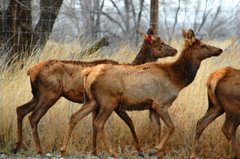
Domesticated elk at Black Canyon Ranch. ((c) Guy Hand Productions)
[BUGLE OF WILD ELK]
CURWOOD: Back here in the U.S. the bugling of wild elk is part of what makes the mountain West so special. It reassures many that the West still has room for at least some of nature's most majestic and untamed creatures. But some of the elk are now caught behind fences. There are 78 elk ranches and hunting preserves in the state of Idaho, alone.
And in the summer of 2006, when a large number of farm-raised elk escaped from a ranch in eastern Idaho it sparked concerns about the mixing of domestic herds with the wild. Critics of the ranches fear the domestic elk could spread disease and alter the wild gene pool. And some of them want Idaho to ban private elk preserves. Producer Guy Hand picks up the story in Boise, Idaho.
HAND: When talk began of outlawing private elk ranches in Idaho last fall, Randy King, executive chef at Crane Creek Country Club in Boise, put together a news conference to show that he and many other chefs support the young industry. Restaurants can't serve wild game, so without domestic elk, King says he wouldn't be able to serve one of the region's most popular foods.
KING: I don't think I've talked to a single chef yet that wants to limit the amount of food that we can provide to our customers. I have not yet spoken to a chef yet that wanted to say, yeah, ban elk-ranching in the state. Not a single one.
HAND: Nearly every northwestern state except Idaho has banned or severely limited the raising of domestic elk.
KING: That's why in my opinion it's so important for Idaho to keep elk-ranching because we are providing a resource, Black Canyon Elk Ranch in particular, the one that I'm really here to support, provides elk to eight different states. They personally go down to Wyoming over to Jackson Hole, over to Oregon and into Montana
HAND: Kristy and Roy Sternes own Black Canyon Elk Ranch.
[ELK SOUNDS]
HAND: On a snowy afternoon in December, Kristy Sternes helps an agricultural inspector count and catalogue their elk herd near Emmett.
K. STERNES: Well, we're working the elk; we're doing part of our annual inventory and inspection by the Idaho Department of Ag. It's where we verify all of our elk to make sure who's here and their I.D. tags, make sure everything’s properly I.D.'d that they've got their metal tags and their color tags. We do it once a year.
HAND: Many of the elk that escaped from a ranch in eastern Idaho last summer didn't have those mandatory visible I.D. tags. That made them much harder to find. And because the owner recaptured many of the animals before authorities could count them, no one knows how many escaped. About twenty are still unaccounted for, according to the Idaho Department of Agriculture. Yet, Kristy Sternes believes the domestic elk industry in Idaho is well-regulated.
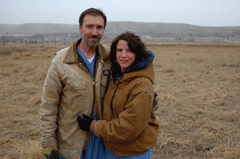
Kristy and Roy Sternes, owners of the Black Canyon Ranch. ((c) Guy Hand Productions)
K. STERNES: Elk are tested for chronic wasting disease, which is the equivalent of mad cow in cattle. And every cow is not even tested for mad cow in the United States upon slaughter. Every elk, however, is. One hundred percent of our elk have to be tested for chronic wasting disease and there's never been a positive one in any of our Idaho herds.
HAND: Domestic elk are also tested for brucellosis and tuberculosis but given all this testing, I asked Kristy why they bothered to raise elk.
K. STERNES: They're just majestic animals, different from the average livestock, and it's like having an "animal planet" out on your own farm, so…
HAND: But it's that mingling of the wild and domestic, the natural and the farmed, that worries those that oppose to elk ranching.
BARTON: Yes, game farms are people's livelihoods but their livelihoods do not touch what Idaho stands to lose if chronic wasting disease wipes out our herds.
HAND: Cherie Barton is with the Idaho Wildlife Federation, one of dozens of organizations that believe that last summer's elk ranch escape was not an anomaly. Besides that escape two hundred and twenty-one domestic elk have broken out of elk ranches in Idaho over the last ten years. And Barton fears all those escapees could not only threaten wild herds with diseases like chronic wasting, but also with unnatural genetic traits that ranchers breed into domestic elk—like massive antlers.
BARTON: If you like to hike and you like to see the animals in the wild. Or you backpack, or you raft, or you use the rivers, canoeing, anything that you're out in the wild and you like to see wild game, you need to help with this issue.
[CROWD SOUNDS]
HAND: Many Idaho hunters agree. It's a bitter cold, cloudless day in January. And on the steps of the state capitol building, Mark Bell, of the Idaho Sportsmen's Caucus is addressing a couple of hundred camo-wearing hunters.
BELL: Idaho is one of the most world-recognized hunting destinations. We have to protect that.
HAND: The Caucus represents about 30 hunting groups and they too think domestic elk could threaten the region's wild herds. Mark Bell:
BELL: If you've ever seen an animal with chronic wasting disease, it's almost pathetic. They jump up and down, they have no sense of control, they fall, they spit and drool, and pretty soon they just die. It is tragic.
HAND: The fact, is chronic wasting disease already exists in wild elk as close by as Wyoming, so transmission could go either way. Critics acknowledge this but they think that elk ranches could speed up the spread of the disease. Yet many say the emotional fuel driving this whole debate isn’t just the fear of disease or genetic impurity, but a profound distaste, for fenced-in elk hunting preserves, what some call "canned hunts," or even "snuff farms." Although most of the 78 elk farms in Idaho raise elk only for meat, much like cattle ranches raise cattle for beef, there are about fifteen operations offering elk for sport hunting.

Domesticated elk at Black Canyon Ranch.((c) Guy Hand Productions)
Hunters can pay more than ten thousand dollars to shoot elk on one of these confined preserves. Mark Bell says the operations simply aren’t compatible with the ethic hunters call “fair chase.”
BELL: And as ethical hunters, the challenge for you and I to go out and harvest an animal in their environment, that's the challenge. I really don't see much of a challenge inside of a fenced compound. That's not hunting and shouldn't be referred to as hunting, it's killing.
HAND: But Ted Rae, an elk breeder speaking at that November news conference, argues that confined hunts have benefits.
RAE: By offering an alternative to our wild herds, we actually create an abundance for everybody. That abundance is created by lessening the demand in impact on our wild resources, on our public resources.
HAND: Some, like Rae, say that the reintroduction of wolves plus poor public land management has caused wild elk numbers to drop. Rae believes private hunting preserves are a logical alternative—and elk ranching a new kind of agriculture.
RAE: It's not just left up to nature, and whether or not that animal can escape a wolf, but that it is allowed to blossom and be fruitful . . .
HAND: Rae likens breeding domestic elk to gardening.
RAE: I think of it often times as finding a wild flower and picking that wild flower and bringing it home and putting it in a pot. You take those seeds and you harvest those seeds and you plant em’ in your garden and you raise those and you raise them again and then some day you plant those again in the wild. It's going full circle.
HAND: It's precisely that "going full circle"—the intentional or accidental release of highly bred, domestic elk into the wild—that opponents of elk ranches and hunting preserves fear most. Idaho state Senator David Langhorst, speaking on the capitol steps, hopes new legislation will plug-up what he sees as a too-porous border between domestic and wild elk.
LANGHORST: There’s wide agreement in the legislature, if not to ban game farms, that at least, we need some kind of licensing with teeth so that bad actors can be put out of business if they need to be. So, to me, if we can ban canned hunts, and minimize the risk at the other farms, I think that that would go a long way to fixing the problem. Now, ah, that's just me. There are many members of the public that I hear from that want the entire practice banned.
HAND: So what are you putting in there now?
KING: A little thyme, a little rosemary, kind of give it the rustic feel.
HAND: Chef Randy King hovers over a domestic elk chop he's sautéing in his Crane Creek Country Clubkitchen.
KING: People come here for the wild experience, for the elk, for the game, so to not be able to put that on the menu, that's ridiculous in my opinion.
Basically, any animal that we have that’s domesticated was once wild. What about the pheasants, the farm raised buffalo, what about the farm raised trout, what about the farm raised sturgeon, what about the farm raised alligators, farm raised ostriches? All those things are wild animals that nobody seems to think twice about, you know. As soon as you've got an elk behind a pen, you know it's a big majestic animal, I can understand the concern but where's the line, where do you get the happy medium at?
HAND: So, where do you draw that line between nature and agriculture? It's a question societies have asked since the first cultivated field, the first tamed animal. Now it's the Idaho legislature's turn. And if it doesn't draw a hard line between the farm and the forest, elk ranching opponents in Idaho say they'll introduce a citizen's initiative that will.
For Living On Earth, I'm Guy Hand in Boise.
KING: Hey Chris! Can you bring me those morsels?
Related links:
- Idaho Wildlife Federation
- New West: "Idaho Lawmakers Focus on Elk Farms"
CURWOOD: Coming up a journey across northern Wisconsin by dogsled. That’s just ahead on Living on Earth.
ANNOUNCER: Support for the Environmental Health Desk at Living on Earth comes from the Cedar Tree Foundation. Support also comes from the Richard and Rhoda Goldman Fund for coverage of population and the environment and from you, our listeners, and from member stations. This is Living on Earth on PRI- Public Radio International.
[MUSIC: John Dunn “(Music created from) DNA of HIV” from ‘Life Music: The Sonification of Proteins’ (Algorhythmic Arts - 1992)]
Borneo: Deforestation and Discovery

The proboscis monkey, seen here in Sarawak, Malaysia, is also known as the "Dutchman."((c) WWF-Canon/Jeffrey McNeely)
CURWOOD: It’s Living on Earth. I’m Steve Curwood. Across the Java Sea from flood-ravaged Jakarta lies the island of Borneo. It’s home to some of the most diverse ecosystems in the world. In the last year alone, more than 50 new plant and animal species have been discovered in the Borneo rainforest. But much of that forest is falling to the chainsaw and the drive for agriculture. That’s why the three countries that share the island—Indonesia, Malaysia and Brunei—have just agreed to preserve as much as a third of Borneo from development. Adam Tomasek is the director of the Borneo and Sumatra Program for the World Wildlife Fund.
TOMASEK: The island itself holds an unbelievable amount of unique animals and plants. The more famous ones such as the orangutans, pigmy elephants, rhinoceros, the gibbons and other monkeys, the proboscis monkey, lizards and snakes galore.
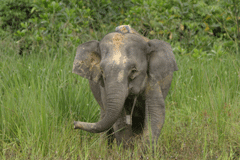
This pigmy elephant, "Roselis," is part of a satellite-based tracking study in the Danum Valley Conservation Area in Sabah (Borneo), Malaysia.((c) WWF-Canon/ A. Christy Williams)
TOMASEK: Well, they all have a very unique, um, adaptation that allows them to literally glide, most of them just being long appendages of skin that allow them to basically parachute down among the canopy of the trees. Many scientists now believe that these adaptations are such that these animals are able to glide as the most efficient way to move between large areas in the forest.
CURWOOD: Tell me about the monkey that the locals call the Dutchman.
TOMASEK: The Dutchman is also known as the proboscis monkey. And, ah they’re quite comical creatures. The males have a very large nose.

The proboscis monkey, seen here in Sarawak, Malaysia, is also known as the "Dutchman."((c) WWF-Canon/Jeffrey McNeely)
TOMASEK: That’s right.
CURWOOD: The male monkeys look like, well, a rather old man who’s, you know, maybe had an awful lot of beer over his lifetime.
TOMASEK: (laughs) Local rumor, local tale, has it that that is exactly why it came to be known as the Dutchman.
CURWOOD: But the scientific reason it has such a big belly is.
TOMASEK: More has to do with the adaptation to the food that it eats. They eat a lot of leaves and some fruit. The actual physical adaptation is such that it has a stomach similar to a ruminant, or a, I guess a cow that we’d be familiar here where there are different chambers in the stomach that allow it to digest the high cellulose content of a lot of leaves.
CURWOOD: I understand that scientists have found more than 50 new species of plants and animals on Borneo in just this last year alone. What kind of things are they finding?
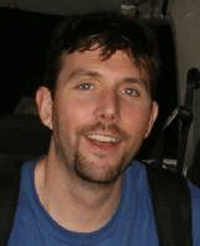
Adam Tomasek is the WWF's Director for the Borneo-Sumatra Program. (Photo: WWF)
CURWOOD: Now, what’s been the effect of development on the search for new creatures on Borneo? I understand it’s quite threatened- the rainforest is disappearing rapidly.
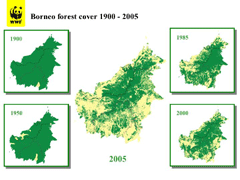
The forest cover on Borneo is quickly disappearing (Photo: WWF)
Development also means that there is a world of attention: financial attention, scientific attention, political and economic attention that’s being focused on the island itself as well. So, we’re looking quite carefully at the impacts of development, which really relates to the issues around palm oil plantations. Palm oil itself is one of the largest drivers of forest loss and forest conversion on Borneo as well as other parts of Indonesia and Malaysia. Indonesia and Malaysia are the two countries that produce the most amount of palm oil in the world, supply around 85 percent or so. And both governments in the last year have announced very aggressive expansion plans.
CURWOOD: What’s the palm oil used for?
TOMASEK: Palm oil is a rather ubiquitous substance. It’s found in a lot of the snacks that we consume on a daily basis; everything from cookies and microwave popcorn to, ah, candy bars. It’s also used in different soaps and shampoos. And we’ve seen a major spike in the global demand for looking at palm oil as a major component of biofuels. It’s quite useful in a lot of different products which really means that is has really large market demand.
CURWOOD: Now I hear that as the forests are cleared for such projects as growing palm oil, that the orangutans have been especially displaced by all of this development.
TOMASEK: Well, orangutans are very sensitive to their habitats. They’re the world’s largest tree dwelling animal. Um, they’re the only one of the great apes that is more arboreal than it is terrestrial as you compare them to the gorillas in particular in Africa. Um, so they’re extremely dependent on trees and healthy forest systems for their food and forage and nesting habits.
CURWOOD: I understand that there’s a three-government agreement to protect what you at the World Wildlife Fund call the "heart of Borneo." Tell me about this agreement.
TOMASEK: The agreement is what we refer to as the Heart of Borneo Declaration. And it was officially launched by the governments of Brunei, Malaysia, and Indonesia just last month. It is analogous to what we’ve seen governments in the Amazon and the Congo Basin over the last few years launch. We’re quite hopeful that this is the real first signs of how the three governments are willing to cooperate to supercede national priorities and, and really look at the island as a single entity that they care deeply about. That they’re committed to actually find solutions to the most pressing of problems.
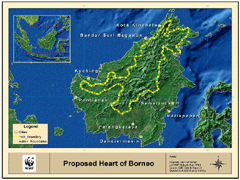
Proposed Heart of Borneo preserve (Photo: WWF)
CURWOOD: You know, what’s the thing that really strikes you about this place? Perhaps a personal story.
TOMASEK: In the middle part of last year we took a group of people from around the world out to experience Borneo. And we were in the Danum Valley. As we woke up in the morning I wandered off before breakfast to have some alone time with all of the delightful sounds of the, ah, forest. And I was sitting on the riverbank looking up as the gibbons started doing their morning calls. The mist was rising up off the river.
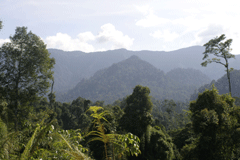
The notheast tip of Borneo, part of the Malaysian state of Sabah. ((c) WWF-Canon/ A. Christy Williams)
CURWOOD: Adam Tomasek is the director of the Borneo and Sumatra Program for the World Wildlife Fund. Thank you so much, sir.
TOMASEK: Thank you very much.
Related link:
WWF's "Heart of Borneo" Project
Low-Carb Diet For Your Car
CURWOOD: Low carb is a diet, right. Well nowadays, low carb doesn’t just mean low carbohydrate to slim down from the excesses of sugar and starch. It also means low carbon, to slim down the energy mix from the excess of carbon rich emissions of gases such as CO2 and methane, that promote global warming. Living on Earth’s Ingrid Lobet reports from Los Angeles on the emergence of low carbon in the lexicon.
LOBET: The other day, California Governor Arnold Schwarzenegger announced that refiners are going to have to start selling more alternative fuel in this state. Only he didn’t exactly say that. He said oil producers would have to start producing more “low carbon fuel” -- ten percent less carbon by 2020. At the announcement, the phrase was suddenly on all the speakers’ lips.
[TAPE MONTAGE OF LOW CARBON FUEL]
It’s easy to see why the governor would announce such a change—California has now capped the amount of carbon it’s allowed to emit. You can expect this new fuel rule to be just one in an ongoing string of carbon-clamping measures.
But what about the use of that phrase? One that few, if any people, have heard before, or can define? It turns out the state is trying to do something new: Ethanol is a compound with two molecules of carbon, compared with eight molecules of carbon in gasoline. But some ethanol, and other so-called alternative fuels, require tons of carbon energy and carbon-based fertilizers and pesticides to grow, then they are transported in tankers that burn carbon fuel to distilleries or refineries that burn more carbon fuel. California is trying to distinguish among the various ethanols and biodiesels, and favor only those biofuels that use less net carbon in their creation and transport.
At transportation research centers at UC Davis and Berkeley, engineers are working out the details for carbon-grading each fuel. They’ll take into account – did it come from corn, or from a waste product? Was it distilled using coal-fired electricity? Or using methane captured off dairy cow manure?
And it turns out the researchers making these calculations will be trading notes with European colleagues. The European Union just proposed a low-carbon standard for its fuels that is almost identical to California’s.
Will other states mandate low-carbon fuel? Their first step would probably be to pass a carbon cap in their legislature. Maryland, Florida and New York may soon consider such moves.
For Living on Earth, I’m Ingrid Lobet.
Related links:
- UC Davis Spotlight: Low-carbon diet
- California Office of the Govenor on AB-32: "Gov. Schwarzenegger Signs Landmark Legislation to Reduce Greenhouse Gas Emissions"
[MUSIC Fela Ransome-Kuti “Truth Don Lie” from ‘The Very Best of Africa’ (Nascente – 2006)]
Mush On!
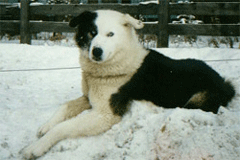
When people go to harness Gonzo, he lays down on the ground with his legs up so they can scratch his belly. (Photo courtesy of Wolfsong Adventures)
CURWOOD: Winter driving, driving you crazy? For a change of pace, try guiding a team of dogs through two feet of snow. Producer Ed Janus traveled to the Bayfield Peninsula of northern Wisconsin to learn the fine art of mushing. He recorded Wolfsong Adventure owners John and Mary Thiel as they showed him and other first time mushers how to ride on the back of a sled at 12 miles an hour, with eight dogs pulling as one.
[FOOTFALLS IN SNOW, BIRD SONG. DOGS YELPING]
M. THIEL: Hey, Java. Starbuck. They love what they do. They just love it.
J. THIEL: People like to do hands-on stuff. I mean, that's the big thing. What they really want to do is handle the dogs. I mean that's the best part of it. So, we have them do everything. They harness the dogs and hook 'em up and drive a team. And when we're done they can come back and feed 'em. And that's people's favorite part.
[DOGS BARKING]
M. THIEL: Kennels often name litters by categories so you can keep track of who the brothers and sisters are. And, my family's very Norwegian, so this is Lefsa, there's a Lutefisk. This is Krumkaka, which is a Christmas cookie.
J. THIEL: We have a blues litter – B.B. King, Buddy Guy, Luther Allison.
[DOGS YELPING]
J. THIEL: You can see in the dogs now, they're starting to get fired up a little bit. You're really working with that enthusiasm. Trying to keep them feeling happy all the time.
[YELPING, JINGLE OF HARNESSES]
M. THIEL: I'm getting the harnesses ready. We'll lay them out ... hey, Jitti, you want to go for a little run? You want to go for a little run? Some of these older guys will just about dress themselves, though. Lift their paw for you.

When people go to harness Gonzo, he lays down on the ground with his legs up so they can scratch his belly. (Courtesy of Wolfsong Adventures)
[JINGLING]
J. THIEL: There you go. Slip it right over his head. You sort of pull it back and…
[YELPING]
M. THIEL: I'm going to do a little sled instruction with you. The skies are called runners; you'll stand there most of the time. The sled will track behind the dogs quite well and you don't have to do a whole lot of steering. You've got a couple different break systems here, which you will use a good deal of the time out on the trail...
[BARKING]
M. THIEL: Let's go, girls! Let's go, girls! Good dogs.
[QUIET SOUND OF SLED ON SNOW, NO BARKING, JINGLING]
M. THIEL: Good Dogs! This is the best part. All that excitement and noise and chaos hooking up and you pull the hook, and it's just instant silence. Good dogs!
[CROW CALL, JINGLING]
J. THIEL: On-by, on-by. I don't know if you saw it up there but Lucy, the little one, she was trying to go right, which would have been "gee." And Lutie, the old experienced leader, said, "no, no, we're not going that way."
[WHISPER OF MOVING SLED]
J. THIEL: We're going about ten miles, 12 – Gee! – 12 miles an hour. Haw, haw, haw Good boy, Lutie, good boy. Come on guys, come on.
[JINGLE OF CHAINS, SLED ON SNOW]
J. THIEL: About this time in the run the dogs usually get in to a bit of a rhythm. And, you can just, sort of, just go through the woods like this, look around a little bit, snow hanging up in the trees.
M. THIEL: You look out over your team and you see them when they really get in the groove, the dogs will move like a wave, you know? Like one animal. It's just a beautiful thing to see em’ running and doing what they love to do. And they're happy and excited and you can't help but be the same.
[FEET RUNNING IN SNOW, SQUEAK OF MOVING SLED]
J. THIEL: We’re going to run up this hill here. The only way to stay warm in the winter when it's really cold out is to run. Take ten steps, jump back on, rest a little bit. I help them up the hills a bit.
[RUNNING SOUNDS]
J. THIEL: Straight ahead. Straight ahead. Try to kick your sled forward as we turn here. Just give a couple of good hard kicks. It'll help you around this corner. Haw. Good dogs. Hold on here.
[GRUNT THEN LAUGH]
Alright! Just hop back on. There you go.
[SLED WHOOSHING IN SNOW]
J. THIEL: Well, I think they're fired up. Now they know they're going home so they're going to – they might want to run a little extra fast. Hup up, Let's go. Let's go.
[SLED STOPS, THEN YELPING AND HOWLING]
CURWOOD: John and Mary Thiel run Wolfsong Adventures in Bayfield, Wisconsin. Our dog sledding lesson and sound portrait was produced by Ed Janus.
[BARKING]
J. THIEL: That was a great ride, kid!
Related link:
Wolfsong Adventures
[MUSIC: DOGSLEDDING SOUND PORTRAIT: Thomas Leeb “Sled Dog Racing” from ‘Riddle’ (Thomas Leeb – 2005)]
CURWOOD: On the next Living on Earth, from tribal village girl to professor to environmental and human rights activist, to Nobel Peace Prize winner, Wangari Maathi of Kenya has grown like the tall trees that she advocates planting. She says everything from poverty to climate change can be fought with a shovel and a seedling.
MAATHI: There are six billion of us. If at least one out of six planted a tree we would very easily reach our target of a billion trees. We are appealing to all of the people throughout the world wherever you are, whoever you are, if you can plant a tree.
CURWOOD: Author and Activist Wangari Maathi next time on Living on Earth.
[SOUND OF GIBBONS]
We leave you this week with a return to the rainforest of Borneo for some jungle love. In the predawn hours, a young male gibbon—a lesser ape—sings some short, sweet songs to woo his potential (ahem) prime-mate.
If he gets lucky, and in this case he sounds like he just might the female responds with what’s known as her “great calls.” John Mitani and Ruth Happel recorded these two apes monkeying around in the forests of Kalimantan, Borneo.
[SOUND OF GIBBONS: “Gibbons” recorded by John Mitani & Ruth Happel in Kalimantan, Borneo for “Pulse of the Planet: Extraordinary Sounds From The Natural World” (Pulse – 2002)]
CURWOOD: Living on Earth is produced by the World Media Foundation. Our crew includes Ashley Ahearn, Eileen Bolinsky, Bruce Gellerman, Ian Gray, Ingrid Lobet, Jennifer Percy, Emily Taylor, Peter Thomson and Jeff Young - with help from Bobby Bascomb and Kelley Cronin. Our interns are Paige Doughty and Meghan Vigeant. Dennis Foley is our technical director. Alison Lirish Dean composed our themes. You can hear us anytime at loe dot org. I'm Steve Curwood, executive producer. Thanks for listening.
ANNOUNCER: Funding for Living on Earth comes from the National Science Foundation, supporting coverage of emerging science; and Stonyfield Farm; Organic yogurt and smoothies. Stonyfield pays its farmers not to use artificial growth hormones on their cows. Details at Stonyfield dot com.
Support also comes from you, our listeners, the Ford Foundation, the Oak Foundation, and the Saunders Hotel Group of Boston's Lennox and Copley Square Hotels. Serving you and the environment while helping preserve the past and protect the future, 800-225-7676.
Living on Earth wants to hear from you!
Living on Earth
62 Calef Highway, Suite 212
Lee, NH 03861
Telephone: 617-287-4121
E-mail: comments@loe.org
Newsletter [Click here]
Donate to Living on Earth!
Living on Earth is an independent media program and relies entirely on contributions from listeners and institutions supporting public service. Please donate now to preserve an independent environmental voice.
NewsletterLiving on Earth offers a weekly delivery of the show's rundown to your mailbox. Sign up for our newsletter today!
 Sailors For The Sea: Be the change you want to sea.
Sailors For The Sea: Be the change you want to sea.
 The Grantham Foundation for the Protection of the Environment: Committed to protecting and improving the health of the global environment.
The Grantham Foundation for the Protection of the Environment: Committed to protecting and improving the health of the global environment.
 Contribute to Living on Earth and receive, as our gift to you, an archival print of one of Mark Seth Lender's extraordinary wildlife photographs. Follow the link to see Mark's current collection of photographs.
Contribute to Living on Earth and receive, as our gift to you, an archival print of one of Mark Seth Lender's extraordinary wildlife photographs. Follow the link to see Mark's current collection of photographs.
 Buy a signed copy of Mark Seth Lender's book Smeagull the Seagull & support Living on Earth
Buy a signed copy of Mark Seth Lender's book Smeagull the Seagull & support Living on Earth

